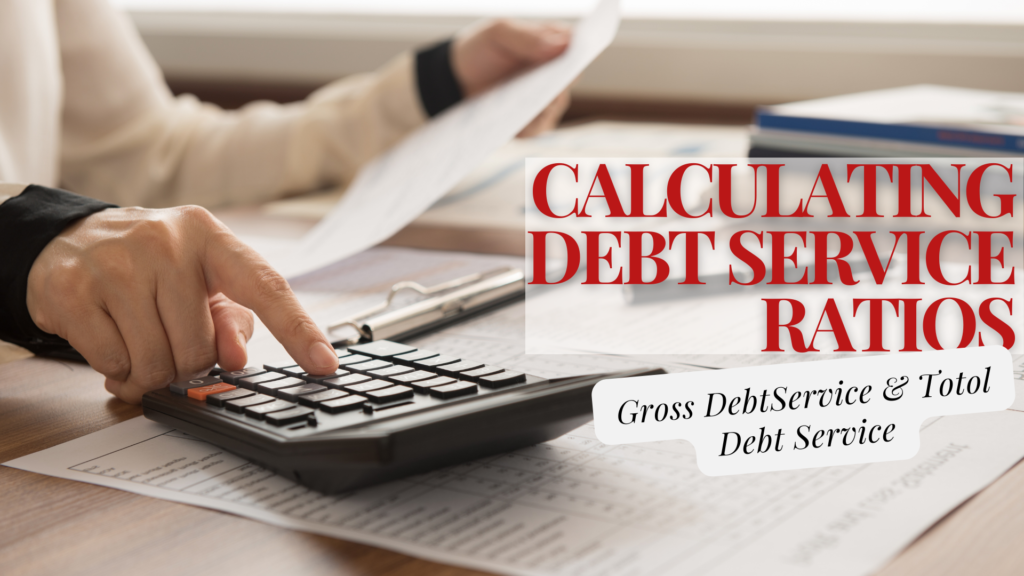Did you know that 1 in 4 Canadian mortgage applications gets declined? This is because of poor Debt Service Ratios (DSRs). Knowing how to calculate your DSR is key to getting a mortgage and staying financially secure. Lenders use the Gross Debt Service (GDS) and Total Debt Service (TDS) formulas for this. GDS measures your housing costs against your income without regard for your other debts. TDS starts by considering GDS, then adds in your other debts like credit cards, student lines, lines of credit, etc.
To get a good mortgage deal, it’s vital to understand these ratios. According to CMHC, GDS should be under 39% and TDS under 44%. Financial planners would argue that you should not spend more than 30% of your income on housing. In terms of debt service ratio, that would be the same as saying you should not have a GDS higher than 30. Given the present cost of housing in Canada, spending less than 30% of your income on housing is quite unlikely. While GDS/TDS of 39%/44% is the guideline followed by lenders who are federally regulated, many lenders are not federally regulated, with some lenders offering GDS and TDS up to 60%. Every mortgage product offered has a minimum debt service ratio that the lender requires a client to qualify for. Further, acceptable debt service ratios are not always in stone and Allen Ehlert can frequently negotiate with a lender if the debt service ratio is ‘close enough’ for a given mortgage product.
Debt service ratios are not only important for lenders to help them manage risk, these ratios also help keep you from taking on too much debt. They encourage smart money management.
Understanding Gross Debt Service Ratio (GDS)
Total Debt Service Ratio (TDS) Explained
Steps to Calculate Your Debt Service Ratio
Importance of Debt Service Ratio in Mortgage Applications
Key Takeaways
- Understanding and calculating DSR is vital for securing a mortgage in Canada.
- GDS includes costs of Principal, Interest, Taxes, and Heating divided by Gross Annual Income.
- TDS includes GDS elements plus other debts.
- CMHC guidelines suggest a maximum of 39% for GDS and 44% for TDS.
- Sticking to these limits prevents taking on too much debt.
- Correct DSR calculations are hugely important for both lenders and borrowers.
By understanding these key points, you can use a mortgage calculator well. This will help you be realistic about what you can afford when buying a home. Stay up to date on Canadian mortgage information to make your mortgage process smoother.

Understanding Gross Debt Service Ratio (GDS)
The Gross Debt Service (GDS) ratio plays a key part in Canada’s housing market. This ratio shows the part of your income taken by the costs of your home. It is important because it lets you and your lenders see how much you spend on home needs.
Definition and Importance
Simply put, the GDS ratio checks if you can afford your home by looking at your income used on it. This includes things like mortgage payments, property taxes, and heating costs. Knowing about this ratio is vital. It helps you avoid financial troubles by keeping track of your housing costs as part of your whole debt-to-income ratio.
By doing this, it helps protect your financial health. It shows if a home is within your budget by looking at your income and usual housing costs.
Components Included in GDS Calculation
The GDS calculation looks at many housing expenses. This gives a full picture of what you spend on housing:
- Principal and interest on your mortgage payments
- Property taxes
- Heating costs
- For condo owners, 50% of condo fees
When you add these up and then divide them by your year’s income, you find your Gross Debt Service (GDS) ratio. This tells you how much of your income goes to your home’s upkeep.
CMHC Guidelines for GDS Ratios
The Canada Mortgage and Housing Corporation (CMHC) provides rules to prevent too much spending on homes. According to the CMHC mortgage rules, your Gross Debt Service (GDS) ratio must stay below 39%. Sticking to these guides is good for your financial health. It keeps your home costs in check.
Knowing and following these ratios is key to getting a mortgage. It makes sure your choices are in line with stable financial practices. It helps lenders too, as they use the Gross Debt Service (GDS) ratio to look at your finances more broadly.
Total Debt Service Ratio (TDS) Explained
The Total Debt Service (TDS) ratio shows lenders your financial health. It covers all your monthly debt, not just housing costs. This includes debts like credit card debts and car loans. Knowing your TDS ratio is key for mortgage applications. It shows if you can handle your debts with your income.
The TDS ratio should be under 44%, according to the CMHC insurance. Staying under this limit proves to lenders that you’re not over your head financially. It shows you can handle both your home and other debts.
Let’s look at what makes up the TDS ratio:
- Mortgage Payments
- Property Taxes
- Heating Expenses
- Credit Card Debts
- Car Loans
- Personal Loans
These parts, plus your income, are how the TDS ratio is calculated. It’s crucial to video all these to get an honest number. Keeping an eye on your TDS ratio helps you stay financially healthy. It means you can afford new loans while paying off the old.
Here’s a look at how different debts affect the TDS ratio:
| Categories | Monthly Payments | Impact on TDS Ratio |
|---|---|---|
| Mortgage Payments | $1,500 | High |
| Property Taxes | $200 | Moderate |
| Heating Expenses | $100 | Low |
| Credit Card Debts | $300 | Moderate |
| Car Loans | $400 | High |
| Personal Loans | $200 | Moderate |
Understanding the TDS ratio helps you be ready for loans responsibly. This means you can keep your money in good shape. It’s useful for getting mortgages and other big financial deals.
Steps to Calculate Your Debt Service Ratio
Finding your Debt Service Ratio (DSR) is crucial for seeing if you can get a mortgage. It helps you know how much of your income can go into housing and other debts. This is key for understanding what you might qualify for.
Required Inputs for Calculation
To calculate the right ratios, you need to know your:
- Gross annual income
- Monthly mortgage payments
- Property tax amounts
- Expected heating costs
- All other debt payments (e.g., credit cards, car loans)
These dsr calculation inputs make sure you include all your financial obligations.
Example Calculations
Let’s say you make $80,000 a year. You spend $1,500 a month on your mortgage, $3,600 yearly on property taxes, and $1,200 a year on heating. To find your GDS ratio:
- Add up your housing costs: $1,500 x 12 + $3,600 + $1,200 = $22,800
- Then divide by your yearly income: $22,800 ÷ $80,000 = 0.285 or 28.5%
Now if you have other debts, like paying $500 a month on a loan, your TDS ratio comes into play:
- Include all debts: $1,500 x 12 + $3,600 + $1,200 + $500 x 12 = $28,800
- Then divide by your income again: $28,800 ÷ $80,000 = 0.36 or 36%
- This gives you the total debt ratio lenders look at.
Using a Mortgage Affordability Calculator
An online mortgage calculator can do all of these complex steps for you. By entering your financial info, it calculates your GDS and TDS with the right interest rates. This shows if you qualify for a mortgage.
Importance of Debt Service Ratio in Mortgage Applications
When you’re applying for a mortgage, knowing about debt ratios (like GDS and TDS) is key. These figures show your financial strength and affect your chance of getting a CMHC mortgage. They make sure you won’t overload your budget with more debt than you can handle.
The GDS and TDS ratios check if you can pay your mortgage and other debts each month. Lenders use them to lower their risks, especially for high-ratio mortgages. Keeping these ratios in check is crucial for getting a good mortgage deal.
Your debt service ratios also affect the prime mortgage rates you get. When lenders see you manage your debt ratios well, they view you as a safer bet. This can lead to lower interest rates. It also encourages better money management and lowers the risk of financial problems later on.
Understanding and working on your Debt Service Ratios is crucial. It’s vital for applying for a mortgage and for your long-range financial health. Meeting the mortgage risk criteria paves the way for stable homeownership and smart financial choices.
Conclusion
Knowing your Debt Service Ratios (GDS/TDS) is key if you want to buy a home. Lenders use these ratios to see if you qualify for a mortgage. They also help you check your own financial health. Keeping within the CMHC’s GDS and TDS limits can save you from money troubles, ensuring you enjoy owning a home sustainably.
When getting ready for a mortgage, it’s vital to keep your debt ratios in line with what’s advised. It helps you plan your finances wisely. Being aware of these ratios makes you smarter in making mortgage decisions. By following these debt guidelines, you make sure you buy a house you can afford. This promotes a strong financial future.
Understanding how to calculate your debt ratio is important for your budgeting. This knowledge helps set realistic goals for how much you can borrow. It allows you to choose homes that fit your budget. Good mortgage preparation and sticking to the CMHC’s rules lead to a better home buying experience.
FAQ
How do I calculate my Debt Service Ratio (DSR)?
To find your Debt Service Ratio (DSR), gather your income, mortgage payments, property taxes, and more. You can use a mortgage calculator for help. This makes it easier.
What is included in the Gross Debt Service (GDS) ratio?
The GDS ratio considers mortgage, taxes, and heating costs. It also includes part of condo fees for condo owners. It tells how much of your income goes towards housing.
What are the CMHC guidelines for GDS ratios?
CMHC says your GDS ratio shouldn’t go above 39%. This limit protects you from being too deep in debt. It helps make sure you can afford your home.
What is the Total Debt Service (TDS) ratio?
The TDS ratio sums up all housing costs and other debts like credit cards. It offers a full look at how you handle all your debts.
How does the TDS ratio impact mortgage qualification?
TDS ratio is important for getting a mortgage. Lenders want to see your total debts fit within 44% of your income. This ensures you can manage your bills and more.
What are the required inputs for calculating Debt Service Ratios (DSR)?
For DSR, you need your income, mortgage, taxes, heating costs, and all debts. Be sure to include secured debts. For credit cards, use a 3% minimum of the balance for a true picture.
Can you give an example of how to calculate GDS and TDS ratios?
With an income of $100,000, a $1,500 mortgage, plus $300 taxes and $150 for heating: GDS = (1,500 + 300 + 150) / 100,000 = 0.0235 or 23.5%. Add $400 for TDS, then TDS = (1,500 + 300 + 150 + 400) / 100,000 = 0.0275 or 27.5%.
How do mortgage affordability calculators help in calculating Debt Service Ratios?
Mortgage calculators make it easy to figure out DSR. Just enter your income and debts. They also check rates and rules, giving you an idea of what you can afford.
Why is the Debt Service Ratio important in mortgage applications?
DSR is key in getting a mortgage. Lenders look to see if you can pay your mortgage and other debts. It’s critical for getting approval, especially for risky high-ratio mortgages.
What role do Debt Service Ratios play in responsible financial planning?
DSRs are key for making smart money choices. They show if your debts and bills match your income. Following CMHC’s advice keeps you from financial trouble and helps you buy a home wisely.












